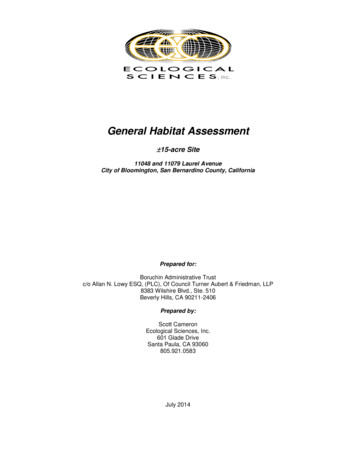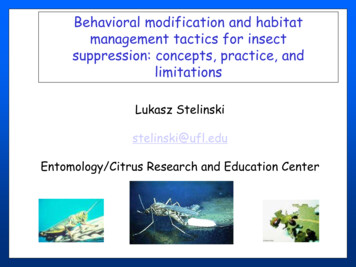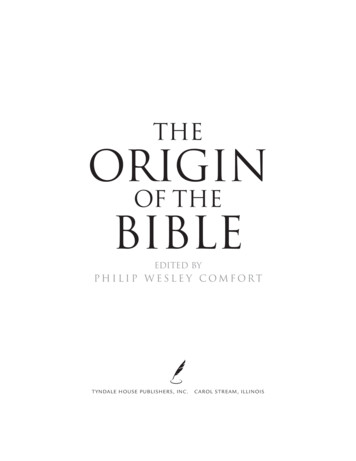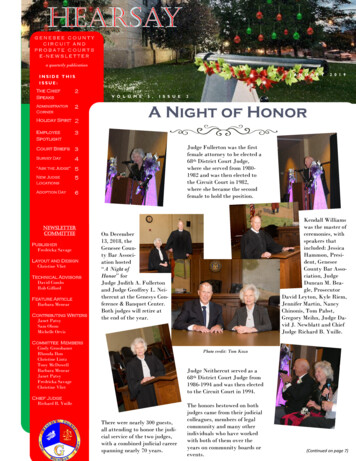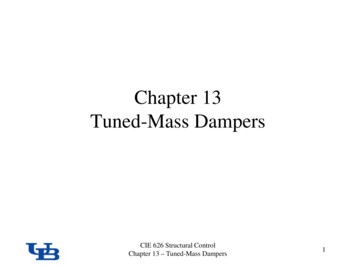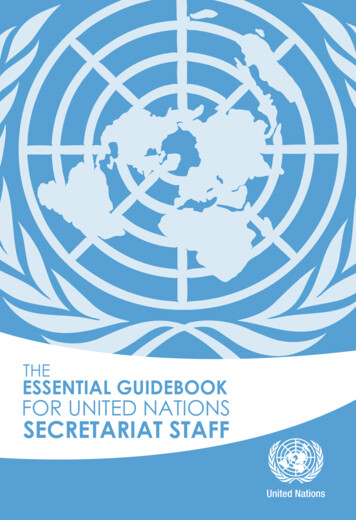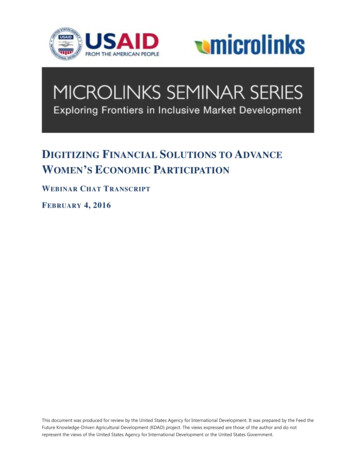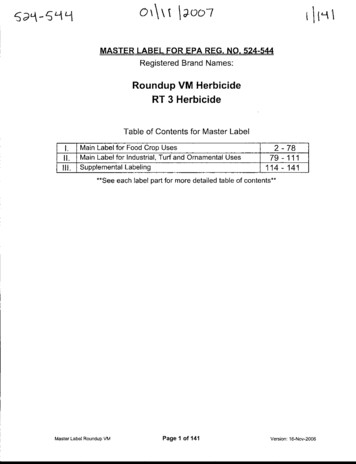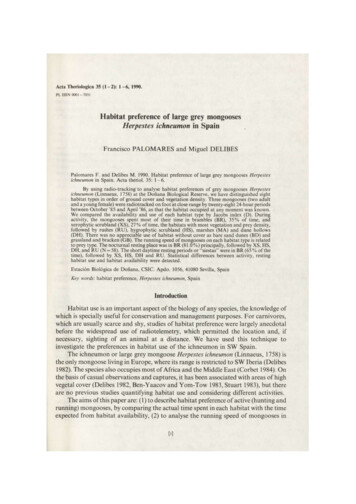
Transcription
Acta Theriologica 35 ( 1 - 2 ) : 1 - 6 , 1990.PL ISSN 0001-7051Habitat preference of large grey mongoosesHerpestes ichneumon in SpainFrancisco P A L O M A R E S and Miguel DELIBESPalomares F. and Delibes M. 1990. Habitat preference of large grey mongoosesichneumon in Spain. Acta theriol. 35: 1 - 6 .HerpestesBy using radio-tracking to analyse habitat preferences of grey mongooses Herpestesichneumon (Linnaeus, 1758) at the D o ñ a n a Biological Reserve, we have distinguished eighthabitat types in order of ground cover and vegetation density. Three mongooses (two adultand a young female) were radiotracked on foot at close range by twenty-eight 24-hour periodsbetween October '85 and April '86, as that the habitat occupied at any moment was known.We compared the availability and use of each habitat type by Jacobs index (D). Duringactivity, the mongooses spent most of their time in brambles (BR), 3 5 % of time, andxerophytic scrubland (XS), 2 7 % of time, the habitats with most vegetation and prey density,followed by rushes (RU), hygrophytic scrubland (HS), marshes (MA) and dune hollows(DH). There was no appreciable use of habitat without cover as bare sand dunes (BD) andgrassland and bracken (GB). The running speed of mongooses on each habitat type is relatedto prey type. The nocturnal resting place was in BR (81.0%) principally, followed by XS, HS,D H , and R U (N 58). The short daytime resting periods or "siestas" were in BR (65 % of thetime), followed by XS, HS, D H and R U . Statistical differences between activity, restinghabitat use and habitat availability were detected.Estación Biológica de Doñana, CSIC. Apdo. 1056, 41080 Sevilla, SpainKey words: habitat preference, Herpestes ichneumon,SpainIntroductionHabitat use is an important aspect of the biology of any species, the knowledge ofwhich is specially useful for conservation and management purposes. For carnivores,which are usually scarce and shy, studies of habitat preference were largely anecdotalbefore the widespread use of radiotelemetry, which permitted the location and, ifnecessary, sighting of an animal at a distance. We have used this technique toinvestigate the preferences in habitat use of the ichneumon in SW Spain.The ichneumon or large grey mongoose Herpestes ichneumon (Linnaeus, 1758) isthe only mongoose living in Europe, where its range is restricted to SW Iberia (Delibes1982). The species also occupies most of Africa and the Middle East (Corbet 1984). Onthe basis of casual observations and captures, it has been associated with areas of highvegetal cover (Delibes 1982, Ben-Yaacov and Yom-Tow 1983, Stuart 1983), but thereare no previous studies quantifying habitat use and considering different activities.The aims of this paper are: (1) to describe habitat preference of active (hunting andrunning) mongooses, by comparing the actual time spent in each habitat with the timeexpected from habitat availability, (2) to analyse the running speed of mongooses in[i]
2 F. Palomares and M. Delibeseach habitat, as an approach to distinguish between different habitat-relatedbehaviours, (3) to describe resting sites and resting habitat preference of mongooses,both at night (they are diurnal) and in the short daytime resting periods ("siestas").Study areaThe study was carried out in the Donana Biological Reserve, on the right bank of the riverGuadalquivir near its mouth, in SW Spain (approx. 37" N, 6 30 W). The climate is subhumid mediterranean,characterized by dry, hot summers and mild, wet winters. The three main biotopes within the area are: sanddunes with pine forests in the dune hollows, scrubland and marshland. These make up a vegetation mosaicwhich has been described in several papers (Allier et al. 1974, Rivas-Martinezi'/ al. 1980). We selected an areaof about 15 square kilometres in the Reserve, and distinguished eight habitat types. A brief description, inorder of decreasing ground cover and vegetation density, is as follows (for more details see descriptions byRivas-Martinez et at. 1980):1. Brambles (BR): formed principally by Rubus sp. with which heathers, gorses Ulc.x sp., rushes and brackenPteridium sp. can be associated (Lonicero hispaniae Rube turn ulmifolii association). It is a very dense habitatof high cover.2. Hygrophytic scrubland (HS): this consists of very dense clumps of heathers Erica sp. up to 3 m high (Ericoscoparidae UUicetum australis and Erico ciliaris Ullicetum (minaris) lusitanici associations).3. Xerophytic scrubland (XS): this mainly consists of Halimium sp. There are also associated Cistus sp.,gorses Ulc.x sp. anci rosemary Rosmarinus officinalis, (Halimio halimifolii Stauracanthetumgenistoidisassociation). The heights reach 1.5 m in some places and the plants offer medium cover.4. Rushes (RU): associations of rushes Juncus sp. of variable height and density (Junto emmauelisEleocliaridelum nuulticaulis and Galio palustri Juncetum maritimi associations).5. Dune hollows (DH): colonized by pines Pinus pinea and varied scrub of rushes Halimium sp. and heathersof variable density. A mixture of the above described associations.6. Marshes (MA): a biotope flooded in the wet season and without water in the dry one. Dominated by seaclub rush Scirpus sp. (Scirpetum maritimi association).7. Grassland and Bracken (GB): grass and bracken pastureland (Trifolio rcsupinati Caricetum chaetophyllae association).8. Bare sand Dunes (BD): loose sand of the dune system with scarcely any vegetation.Proportions of above mentioned habitats were 5.1, 16.1, 32.8, 8.6, 7.3, 25.3, 3.0, and 1.8%respectively.MethodsBetween September 1985 and April 1986 four mongooses: two adult females (H5 and H6) and twosubadult or young females (H 1 and H4) were fitted with radio-collars working on the 151 MHz range andprovided with tip switches sensors. The animals were tracked for periods of 50 (H5), 128 (H6), 17 (H4) and210 (HI) days.Habitat use, nocturnal resting place, and running speed, were estimated from 28 independent 24-hourperiods of continuous tracking of three animals (HI, H5 and H6). H4 was a female cub of H6 and duringthe tracking period showed a similar use of habitat as its mother. Radio signals were used to locatethe animals, which were tracked on foot at close distance, which allowed us to know the habitat occupiedat any moment. Resting was detected through the tip switch sensor.We noted the time spent by each active individual within each habitat type and compared it with theavailability (percentage) of each habitat in the minimum convex polygon (Macdonald el al. 1980) usedby this individual. Results of the twenty-eight 24-hour periods were pooled. In the analysis we have not
Habitat preference of mongoose3included isolated locations obtained over the tracking periods by triangulation, as there is an error associatedwith this method (Tester and Siniff 1965, Heenze and Tester 1967), which in a mosaic environment couldproduce serious biases (Saltz and White 1990).Mongooses are diurnal in the study area, resting for 16 hours on the average each night and 2 morehours of "siesta" by daytime (Palomares 1986). Thus, for nocturnal resting we detected habitat preferencefrom the number of nights on each habitat type, while habitat preference for daytime siestas was derived fromtime spent in them.Running speed was estimated from the distance covered in half-an-hour periods. Habitat preferenceswere estimated by the Jacobs index (Jacobs 1974) which varies from 1 (maximun preference) to — 1(minimum preference). Statistical differences between availability and use of habitats were estimated bychi-square tests and Tukey test. Average time spent and running speed in each habitat were compared withi-tests.Results and discussionHunting and travelling habitatThe mongooses spent most of their active time in BR (35%), followed by XS(27%), RU (15%), HS (12%), M A (6%) and D H (4%) (Table 1). There was noappreciable use of BD and GB, which they only used to cross from one habitat type toTable 1. Percent of use (PU) of each habitat type for hunting, "siestas", and resting, index of Jacobs (Z)) toestimate habitat selection, and average ( x ) running speed on each habitat. The significance of Tukey testbetween availability and use of each habitat type is shown in each column. 0 . 0 5 , **/ 0.01, ** 0.001, ns not significant, a half an hour —periods.Habitat typeXerophytic scrubland (XS)Hygrophytic scrubland (HS)Brambles (BR)Rushes (RU)Marshes (MA)Dune hollows ( D H )Grassland and bracken (GB)Bare sand dunes (BD)Huntingn 9941 min.Siestasn 3148 min.Night restingn 58 ni ghtsRunning 44442013——--Table 2. Statistical significance of the comparison by the Student t-test of the average time (AT)spent in each habitat during activity and the average running speed (S) on each habitat. 0 . 0 5 , 0 . 0 1 , " 0 . 0 0 1 , ns not significant.Time (AT)Xerophytic scrubland (XS)Hygrophytic scrubland (HS)Brambles (BR)Rushes (RU)Marshes (MA)D u n e hollows (DH)XSHSSpeed nsnsnsns****—*********—****ns—*****ns-
4F. Palomares and M. Delibesanother and usually at a great speed. Time spent on BR and XS was statistically greaterthan that in any other of the habitat types. The differences were also significantbetween time spent in R U and D H , and D H and HS (Table 2).Habitat types were not used in proportion to their availability (Table 1). There aretwo preferred habitat types with positive Jacobs' index: BR (Z) 0.78; 7 23.5, p 0.001) and R U (D 0.26; q 5.4, p 0.001). The other habitats were rejected (negativeJacobs' index), especially among those used now and then, M A (D--0.67; 7 16, p 0.001) (Table 1).Apparently, mongooses spend more time searching in habitats richer in prey. Inthe study season and in the study area, ichneumons mainly feed on small mammals(mice and shrews), rabbits Oryctolagus cuniculus and carrion, in that order ofimportance, although reptiles, birds, amphibians and some insects are also taken(Palomares 1986). BR and HS support the higher diversity and abundance of smallm a m m a l s in the area, but Mus spretus which is an important species in the diet of themongooses, also reaches high densities in R U (Kufner 1986, C a m a c h o and M o r e n o1989). Mongooses mostly take rabbits in their burrows (F. Palomares and M. Delibesunpubl.), which are found in greater abundance in XS. Finally, carrion, consistingmostly of Sus scrofa, is mainly found in areas of rushes a r o u n d the marshes. In thestudy season mongooses avoid flooded marshes (MA), where introduced Americancrayfish, a potential prey, breed.Habitat-related running speedThe speed of mongooses' running on each habitat type is shown in Table 1. Theymove more slowly in HS and BR, and more rapidly in M A and XS. Average speed inHS and BR differs statistically from that in the remaining habitats except D H . Averagespeeds in R U and M A also differ (Table 2).A relationship seems to exist between running speed in each habitat and the preyspecies obtained in it. Mongooses move slowly in BR and HS, where the capture ofsmall and evenly distributed mice and shrews requires a m a j o r searching effort andaccordingly a low speed. On the other hand, the burrows of rabbits are found in fixedand predictable sites, primarily in XS, and mongooses move faster in this type ofhabitat, with direct and rapid movements towards the rabbit warrens. In R U , wheremongooses principally search for carrion and mice Mus spretus searching effort andspeed are intermediate: carrion is a large static food resource easily detected, while micedetection requires a greater searching time. Finally, in D H , a habitat containing verydiverse scrub, the speed of movement was also intermediate.Resting habitatBR was chosen to rest 81.0% of the nights considered (« 58), followed by HS(12.1 %), D H (3.4%), XS (1.7%) and R U (1.7%) (Table 1). The observed frequenciesof use were statistically different f r o m those expected from habitat availability (y2 76.087, p 0.001) (Table 1). The only habitat preferred was BR (D 0.93, 7 51.1,
Habitat preference of mongoose5p 0.001), the other being rejected with high negative values of D, except in the case ofHS (Z) -0.15; q 3.3, /? 0.05) (Table 1).We have tried to determine the precise resting site on each occasion. Most of thetimes (70.7%) sites were inside bramble thickets, followed by underground burrows(17.2%), heather thickets (10.4%) and flattened rushes in the open air at marshes(1.7%). Probably, the importance of underground burrows to rest was underestimated, as very often we were unable to reach the exact location of the resting site,being hidden by brush or bramble thickets (for instance, Beltran et al. 1985, recovereda dead individual inside a rabbit warren under brambles). Presence of undergroundburrows used by mongooses was detected in BR, XS, D H and the edges of HS. Theseburrows were not built by the mongooses themselves, as rabbit warrens and badgerssetts (sometimes occupied by badgers Meles meles) were used.Most of the time devoted to "siestas" was spent in BR (65.9%), followed by HS(11.7 %), XS (8.8 %), D H (7.8 % ) and R U (5.7 % ) (Table 1). The different habitat typeswere not used according to their availability (Table 1). The preferred habitat for"siestas" was BR (Z) 0.90, 41.2, /? 0.001), followed by R U (Z) 0.21, q 3.3,/? 0.05) and D H (Z) 0.07, q 0.1, ns). The remaining ones were rejected with highD values, except HS (Z) -0.15, q 3.7, p 0.01) (Table 1). Average time spent in BRdiffers statistically from that spent in other habitats (t 4.489, 4.495, 4.939 for XS,H S and R U respectively; p 0.001). On XS and D H we confirmed on most occasionsthat "siestas" occurred in underground rabbit warrens.ConclusionsOur short distance radio-tracking of mongooses during activity and restingenabled the patterns of habitat use to be distinguished, avoiding the common biasassociated with the triangulation technique (for commentaries see White and Garrott1986, Kufeld et al. 1987, Saltz and White 1990).Large grey mongooses in general preferred areas with high cover and protection.Overall, the quantitative results from the present study matched with what could bepredicted from anecdotical observations (Delibes 1982, Ben-Yaacov and Yom-Tow1983, Stuart 1983). The data demonstrate that a greater diversity of habitat types wasused for hunting and running activities (B 2.13, diversity index, Levins 1968) than forresting, as well as both at night ( 0.69) and during the "siestas" ( B 1.5) in themiddle of the day. In the resting period much more concentration on areas offeringgreater protection (principally BR and to some extent HS) was detected. Preyavailability seems to be the more important factor affecting hunting habitatpreferences, while the presence of safe sheltering (abundant vegetal cover and rabbitwarrens) would condition the selection of resting habitat.Overall, mongooses showed preferences in their use of habitat, especially forresting. Dense patches of vegetation with brambles and underground burrows play animportant role in their activity, as is proved by BR, representing only 5 % of the
6F. Palomares and M. Delibesavailable habitat. This was used to rest 8 0 % of the nights and 6 6 % and 3 6 % of thetime devoted to "siestas" and to hunt respectively. For hunting, mongooses showa more diverse pattern of habitat use, but they practically never utilize bare open areas.Acknowledgements: The research was supported by D G I C Y T (project PB87-0405). One of the authors(FP) has a grant of PFPI of Ministerio de Educación y Ciencia. We thank two anonymous referees forreviewing the manuscript and N. Bustamante for reviewing the English.ReferencesAllier C., González Bernaldez F. and Ramírez Diaz L. 1974. Mapa ecológico de la Reserva Biológica deDoñana. CSIC, Estación Biológica de Doñana, Sevilla.Beltrán J. F., Delibes M. and Ibañez C. 1985. Immobilization and marking of the Egyptian mongoose,Herpestes ichneumon (L.), in Spain. Z. Sáugetierk. 50: 243-244.Ben-Yaacov R. and Yom-Tow R. 1983. On the biology of the Egyptian mongoose, Herpestes ichneumon, inIsrael. Z. Sáugetierk. 48: 3 4 - 4 5 .Camacho J. and Moreno S. 1989. Distribución espacial de micromamíferos en el Parque Nacional deDoñana. Doñana Acta Vert. 16: 239-245.Corbet G. B. 1984. The mammals of the Palearctic Region: a taxonomic review. British Museum (NaturalHistory). Cornell Univ. Press, London: 1 - 3 1 4 .Delibes M. 1982. Notas sobre la distribución pasada y actual del meloncillo Herpestes ichneumon (L.) en laPenínsula Ibérica. Doñana. Acta Vert. 9: 341-352.Heenze K. L. and Tester J. R. 1967. Evaluation of radio-tracking by triangulation with special reference todeer movements. J. Wildl. Manage. 31: 124-141.Jacobs J. 1974. Quantitative measurements of food selection. A modification of the forage ratio and Ivlev'sElectivity Index. Oecologia (Berl.) 14: 413-417.Kufeld R. C., Bowden D. C. and Siperek J. M., Jr 1987. Evaluation of a telemetry system for measuringhabitat usage in mountainous terrain. Northwest Science 61: 249-256.Kufner M. B. 1986. Tamaño, actividad, densidad relativa y preferencias de habitat de los pequeñosy medianos mamíferos de Doñana, como factores condicionantes de su tasa de predación. Ph. D. thesis,Univ. Autonoma de Madrid. Fac. de Biología.Levins R. 1968. Evolution in changing environments. Princeton, New Jersey. University Press.Macdonald D. W., Ball F. G. and Hough N. G. 1980. The evaluation of home range size and configurationusing radio tracking data. [In: A handbook on biotelemetry and radio tracking. C. J. Amlaner and D.W. Macdonald, eds]. Pergamon Press, Oxford: 405-424.Palomares F. 1986. Ecología de la gineta y el meloncillo en el Parque Nacional de Doñana. M. Sc. thesis,Fac. de Ciencias. Univ. de Granada: 1 - 1 8 6Rivas-Martínez S., Costa M., Castroviejo S. and Valdes E. 1980. Vegetación de Doñana (Huelva, España).Lazaroa 2: 1 - 1 8 9 .Saltz D. and White G. C. 1990. Comparing different measures of the error involved in radio-telemetrylocation. J. Wildl. Manage. 54: 169-174.Stuart C. T. 1983. Food of the large grey mongoose Herpestes ichneumon in the south-west Cape Province. S.Afr. J. Zool. 18: 401-403.Tester J. R. and Siniff D. B. 1965. Aspect of animal movement and home range data obtained by telemetry.Thirtieth North American Wildlife Conference 30: 379-392.White G. C. and Garrott R. A. 1986. Effects of biotelemetry triangulation error on detecting habitatselection. J. Wildl. Manage. 50: 509-513.Received 9 November 1989, accepted 22 July 1990.
Habitat preferenc of large gree y mongoose s Herpestes ichneumon in Spain Francisco PALOMAREanS d Migue DELIBEl S Palomares F. an dDelibeMs. 1990 Habita. preferenct of large gree mongoosey Herpestes s ichneumon i Spainn Act. theriola 35. 1-6: . By usin radio-tracking to analysg habitae pr
